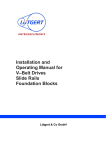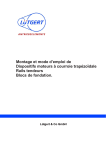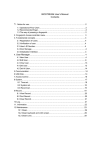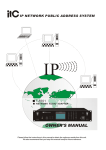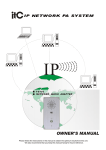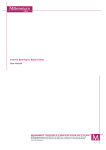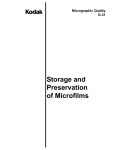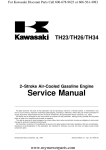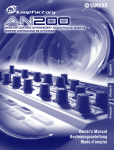Download Installation and Operating Manual for
Transcript
Installation and Operating Manual for • V–Belt Drives • Slide Rails • Foundation Blocks www.luetgert-antriebe.de Installation and Operating Manual V–Belt Drives • ·All V–belts used should be manufactured in conformance with standards. Thoroughly remove any residues of oil and grease and other contamination. No traces of rust are admissible on the V-belt pulleys, especially in the area of the wedged grooves. • ·All V–belts used should be of one original set of identical length. Avoid mixtures of V–belts of different manufacturers. The V–belts should have been stored free from damages and to the state of the art according to manufacturer´s specifications. You can clean dirty V–belts with a mix of glycerine and spirit in the ratio of 1:10. • ·It is important to install the V–belt pulleys parallel to the axis and aligning each other. Make sure that pulley concentricity and run–out tolerance will not exceed the predefined limit values according to DIN 2211 or 2217 (also refer to Table 1). • ·For installation, approach the belt pulleys to each other until the V–belts can be mounted without using force. It is prohibited to use any aids, such as tire levers or similar, since this might lead to damage of the V–belts. • ·If you have mounted the V-belts conforming to the grooves, tighten the drive according to manufacturer´s specifications. For this purpose, tighten the belt pulley, which can be moved parallel to the axis for tightening, by slowly turning the drive until the V–belt has reached the required initial tension. Always check the belt inital tension perpendicularly to the drawing part • of the belt (load part) by means of appropriate strain viewers. Refer to Table 2 for the required amounts for inital tension, by using the impression depth mentioned on the continuation page of this Manual. • After a first service period of approx. 0.5 to 2 hours, check the belt initial tension again and retighten, if required. After further approx. 20 operating hours under load, it is recommended to check and retighten again in order to compensate for the V–belt stretching during the start–up period. • V–belt drives using high–capacity V–belts of standardized profile series are mainly maintenance–free during operation for their entire service lives. It is advisable to regularly inspect the belts and belt pulleys for any trace of damage and wear and tear. Table No. 1 Effektive Ø from to Admissible pulley concentricity and run-out tolerance 50 100 106 160 170 250 280 400 450 630 710 1000 1120 1600 1800 4000 0,2 0,3 0,4 0,5 0,6 0,8 1,0 1,2 Table No. 2 Profil Ø small Pully [mm] Test force [N] SPZ SPA 63 - 180 90 - 140 160 - 250 140 - 200 224 - 400 224 - 315 355 - 630 25 50 50 75 75 125 125 SPB SPC Impression depth per 100mm Length of freerunning part of belt 2,3 3,2 2,7 3,7 2,7 3,2 2,7 L = Length of free-running part of belt F = Test force Ea = Impression depth of freerunning part of belt Example of application: Profile SPB, Ø small pulley (e.g. motor pulley) = 180 mm, length of free–running part of belt = 460 mm Test force from the Table = 75 N, impression depth = 3.7 x (460//100) = 17 mm. Installation and Operating Manual Taper Bush The Taper Bush system consists of conical clamping bushes with various bores in standardized sizes and the V–belt or flat belt pulleys with appropriately executed conical bore. The advantages of the taper bush system are easy assembly and dismantling and the capacity of the belt pulleys to adapt to different bore diameters by exchanging the corresponding taper bush. Assembly • Clean all polished bush surface from grease, oil and dirt prior to assembly. Such surfaces are, in particular, the bore, the outside cone of the bush and all semi–bores and semi–thread bores. Also degrease the conical bore of the belt pulley. • Introduce the taper bush now into the hub of the pulley until the specific semi–bores in the hub and in the bush coincide. Make sure that every thread ( semi–thread) in the bush corresponds to a smooth semi-bore in the hub and vice versa. The fastening screws for the bush included in the supply are slightly lubricated with oil at its thread, point, and bottom part of its head and manually screwed into the provided holes. Further keep in mind that the fastening bores are those, which are provided with a semi– thread in their hubs. • Now push the belt pulley unit with the pre–assembled taper bush to its correct position of the shaft. When using a key scat, insert key first into keyway of shaft prior to assembling the bush. Only use keys supporting on their edges. Now tighten the fastening screws of the bush uniformly and step–by–step with the help of a torque wrench until reaching the recommended starting torque according to Table No. 3, in order to prevent any cocking between bush and pulley. Make sure that, at first, the bush is clamped on the shaft, and that the hub slides into its end position only afterwards. With light blows of a hammer on a sleeve or a wooden block, you can drive down the clamping bush into the cone to slightly increase the clamping effect. After that, the screws can be tightened until the recommended starting torque is obtained. Never exceed the starting torques mentioned in the assignment table. • With perpendicular shaft arrangement and particularly rough operation (shock load), take further safety precautions against any movement of the taper clamping bush on the shaft. • Empty bores are filled with grease to avoid penetration of dirt or foreign substances. After a short warm–up period of the drive under load, it is recommended to check the fastening screws of the taper clamping bush. Dismantling For dismantling, loosen all the fastening screws of the taper bush degrease the bores filled with lubricant. Degrease the pull–off bores, up to 2 items according to the bush size each, and slightly lubricate them with oil. Yu can recognize the pull–off from the fact that the relevant semi–threads are located on the bush side. · The screws are screwed into the pull–off bores and steadily tightened until the taper bush comes free from the hub and is freely moveable on the shaft. · The parts can now be removed from the shaft. Table No. 3 Bush No. 1210 1610 1615 2012 2517 3020 3030 3535 3525 4040 4030 4545 4535 5050 5040 6050 7060 Bush bore mm 16 19 24 32 19 24 38 42 24 38 42 48 50 24 38 42 48 55 60 38 48 55 60 75 42 60 75 90 48 60 75 100 55 75 100 110 75 100 125 100 125 150 125 150 175 Theoretical slip torque without key Recomended screw tightening torque, max. [Nm] 82 105 142 210 98 135 240 265 165 310 340 400 420 220 380 430 510 600 670 520 730 890 970 1300 1000 1580 2150 2600 1700 2150 3150 4400 2500 3900 5500 6300 3950 5650 7370 8950 11900 14900 15600 19400 23200 [Nm] 15 15 25 35 70 85 120 140 200 550 550 Tightening and slip torques for taper bushes The indicated slip torques for the corresponding tightening torques were determined on the test bench for the respective bore Ø and theoretical values for frictiontype connection without key. If impact loading occurs then the slip torque should be divided by 2. In principle it is recommended that the bushshaft connection is always made with a key. The recommended tightening torques should not be exceeded and are sufficient to secure the connection between the shaft and the bore against axial slip during normal operation. For impact-loaded, vibrating or suspended operation, an additional mechanical retaining device should be fitted to prevent slippage or creeping on the shaft. Trouble–Shooting Table FAULT POSSIBLE CAUSE REMEDY Broken belt(s) Insufficiently rated drive New calculation required Belt is rolled or levered on pulley On assembly, use retightening option Foreign body dropped into drive Extreme shock load Install suitable safety device or drive protection PREMATURE BELT FAILURE New calculation to adapt to shock load Belt(s) do(es) not resist load (creep); no visible cause New calculation required Traction body damaged Keep to correct assembly method Worn–out pulley grooves Check groove wear, replace, if required Movement axle distance Check drive for axle distance movement during operation Failure lateral assembly Belt spalling and substructure detaching Non–aligning pulleys Check and correct alignment Traction body damaged Keep to correct assembly method Pulley too small Check drive design, use larger pulleys Traction body damaged Increase diameter of outer tightening roller accordingly Wear on the upper belt shell STRONG OR UNUSUAL BELT WEAR‚ Insufficiently rated drive Friction on safeguarding equipment Replace or repair safety equipment Malfunction of tightening roller Replace the tightening roller Wear on the upper belt edge Incorrect belt pulley seat (belt too small for groove) Use the correct belt–pulley combination Wear on flanges Belt creep Retighten until creep is gone Non–alignment Realign pulleys Worn–out pulleys Replace pulleys Wrong belt Replace by correct belt size Incorrect belt–pulley seat Use the correct belt–pulley combination Wear on lower belt edge Worn–out pulleys Replace pulleys Wear on lower belt shell Crack formation in substructure Belt substructure on pulley groove (belt too small for groove) Use the correct belt–pulley combination Worn–out grooves Replace pulleys Dirty pulleys Clean pulleys Pulley diameter too small Use larger pulley diameter Retightening Belt creep Outer tightening roller too small Incorrect storage Use larger diameter for outer tightening roller Do not stretch belt too tight, do not bend or inflect. Avoid heat and direct sunlight STRONG OR SUUNUAL BELT WEAR POSSIBLE CAUSE REMEDY Burned out and hard edges and substructure Belt creep Retighten until creep is gone Worn–out pulleys Replace the pulleys Insufficiently rated drive New calculation of drive Wavy movement Check if there are any changes in the axle distance Extreme hardening of belt shell Hot surrounding of belt Improve drive ventilation Flocky, sticky or swollen belt surface Pollution through oil or chemicals at belts or in the pulleys Do not use belt stretching agents; remove oil, grease or chemicals Individual or composite belts Shock load or vibration Check drive design, use Power Band V– BELTS TWIST OR JUMP OFF THE DRIVE FAULT BELT EXTENSIOND BEYOND RETIGHTENING VALUE Shield grooves and drive Non–aligned pulleys New alignment of the pulleys Worn–out pulley grooves Replace pulleys Traction body damaged Use correct assembly and storage Procedures Wrong position of flat tightening roller Wrong belt set Carefully insert flat tightening roller into loose part of belt, as close as possible to the driving pulley Inappropriate drive design Replace with new belt set. Do not mix old and new belts Check stability, axle distance and means of reducing vibration Composite belts will not extend uniformly Individual belts or all belts expand in the same way Non–aligned drive Realign and retighten drive Dirty pulleys Clean pulleys Broken traction body or damaged Substructure Replace all belts, assemble properly Wrong belt set Assembly the correct belt set Not sufficient clearance for retightening Check the amount of retightening Recalculation of the drive High overloaded or not sufficiently rated drive Replacement of belts, crrect assembly Broken traction bodies Whistling or “chirping“ NOISE CAUSED BY BELTS Foreign substances in pulley grooves Whipping noise Grinding noise Belt creep Retightening required Dirt Clean belt and pulleys Loose belt Retightening required Flat belt set Insert correct belt set Non–alignment New alignment of pulleys, so that all pulleys are equally loaded Safety equipment is in grinding contact Repair, replacement or new design of safety equipment NOISES CAUSED BY BELTS FAULT POSSIBLE CAUSE REMEDY Grinding noise Bearings are damaged Replace, align and grease Unusually loud drive Wrong belt Use correct belt size Worn–out pulleys Replace pulleys Dirt on grooves Clean pulleys, improve protection. Remove rust, colour or dirt from grooves Fluttering belts Excessive vibration in drive system Retighten Wrong belt sets Assemble new belt set Non–alignment of pulleys Alignment of pulleys Wrong belt Use proper belt profile section for each pulley UNUSUAL VIBRATION Unsuitable design of machinery or Equipment Check structure and clips for correct tightness Pulleys jumped out Replace pulley Loose drive components Check all machine parts, safety equipment, motor supports, motor padding, bushes, clips and housing for stability, appropriate construction thickness, correct maintenance and assembly Cover band coming off FAULTS WITH COMPOSITE V– BELTS Tension of belt is too low Worn–out pulleys Replace pulleys Wrong groove space Measure pulley grooves and replace with standard pulleys Safety equipment is obstructed Check safety equipment Malfunction or damage of outer tightening roller Repair or replace outer tightening roller Composite belt comes off the drive Dirty pulleys Clean grooves, use individual belts to avoid dirt collecting in the grooves One or several ribs are miss tracking outside the pulley Non–alignment New alignment of drive Tension is too low Retighten Worn–out or damaged cover band of belt FAULT POSSIBLE CAUSE REMEDY Broken or damaged pulley Wrong assembly of pulleys Do not tighten bush bolts beyond recommended torques Pollution Foreign substances in drive FAULTS WITH PULLEYS Excessive circumferential speeds Wrong assembly of belts Keep circumferential speed of pulleys below recommended maximum limits Do not use levers to mount belts on Pulleys Strong, fast wear of grooves Excessive tension of belts Retighten, Sand, dirt or other pollution check drive design Clean and protect the drive to the optimum extent Bent or broken shaft FAULTS WITH DRIVE Use appropriate safety equipment for drive Extreme overstrain of belts Retighten Over–dimensioned drive* Check drive design, mount smaller belts or fewer belts if required Accidental damage Recalculation of safety equipment Error of machine design Check machine design Safety equipment damaged Damage by error or inappropriate design of safety equipment Repair, rate referring to long life Over–tightened drive belt Worn–out grooves, belt makes contact, but no power is transmitted unless it is Over tightened Replace pulleys, tighten the drive properly Retighten HOT STORE Wrong tension Diameter of pulley too small Diameters of pulleys prescribed by motor manufacturer were not observed Recalculation of drive Bad condition of bearings Over–dimensioned bearings Check bearing calculation Insufficient maintenance of bearings Align and lubricate bearings Error or obstacle Position the pulleys as close as possible to bearings, Pulleys are seated on shaft too close to the front eliminate obstacles Belt creep Tension of drive is too small Retighten * Too many drive belts or too wide ones can strongly affect the motor or driving shafts. This may occur if load requirements for a drive are reduced, but the belts are not recalculated accordingly. This can also occur by calculation of too high quantities for belts. The forces arising due to belt tension will be too high for those shafts. Instructions for Foundation Block Installation Regarding their functional dimensions, the foundation blocks are conforming to DIN 799. They are manufactured of the material EN–GJL 200 in accordance with DIN EN 1561. For installation, use foundation blocks without any paint. Prepare openings in the provided cement floor in specified sizes referring to DIN 799 where the foundation blocks can be sealed. To prevent concrete or mortar from penetrating into the threads, seal them or fill them with grease. For pouring the openings, use concrete of the same solidity and granulation classes as for the surrounding concrete surfaces. D1 M 10 M 12 M 16 M 20 M 24 M 30 M 36 M 42 M 48 L1 125 150 180 200 250 280 340 425 475 D3 56 72 85 100 125 140 180 225 250 D5 M8 M 12 M 12 M 12 M 16 M 16 M 20 M 20 M 24 Fitting Example Foundation Block L2 35 40 50 56 70 79 100 120 129 L3 20 22 25 28 36 40 50 60 64 m1 8 10 12 14 18 20 25 28 30 m2 16 20 20 20 25 30 25 30 32 Installation and Operating Manual Motor Slide Rails 1. Quality Slide rail made of material: EN–GJL–200 according to DIN 1561. Fastening screws for the machine, as well as straining screws, are included in the supply. Stone bolts with hexagonal nut for anchoring are to be ordered separately. 2. Safety Precautions Screws coming loose are very dangerous. Always make sure that you keep to the prescribed starting torques for the screws, and to check them regularly. Never carry out adjusting work with the machine running. Make sure to lock the main switch of the machine against unintentional restarting. 3. Mounting the Slide Rail When fastening the slide rails to foundations, check, prior to tightening the stone bolts, the firm seat of the foundation screws after the specified setting period. When fastening the slide rails on frames, plates and such, use rails with machined base surface in order to avoid breakage due to distortion. All contact surfaces should be even and properly aligned. 2 3 1 1 Slide rail 2 Tightening screw 3 Fastening screw and nut The connecting screws may not turn themselves; there must be enough space for the wrench. 3.1 Arrangement of slide rails Keep to the motor foot distance X. Arrangement of slide rails acc. to Fig. 1. Make sure that the slide rails are placed in parallel. Maximum parallel deviation should not exceed X +/- 1mm. The height relating to each other can be checked with a spirit level. X 3.2 Slide Rail Design Fig. 2 Lightweight version A up to 650 mm and DIN 42923–version up to 500 mm Fig. 3 Lightweight version B up to 700 - 1500 mm and DIN 42923–version from 630 - 1000 mm Fig. 4 Lightweight version C from 1600 - 2200 mm and DIN 42923 Version - 1250 mm Fig. 5 Heavy version WEN 40003 4. Fastening the Motor Place the motor on the slide rail and tighten the fastening nut until, at first, the motor still remains moveable. Accurately align the motor by means of the straining screws. With flat belt drives or chain drives, adjust the required initial tension (keep to supplier´s instruction). Then definitely tighten the fastening nuts.. Notes LÜTGERT-DRIVES V–Belts V–Belts Flat Flat Belts Belts V–Belt V–Belt Pulleys Pulleys Flat Flat Belt Belt Pulleys Pulleys V–Ribbed V–Ribbed Pulleys Pulleys Conical Conical Pulleys Pulleys Cage–Type Cage–Type Pulleys Pulleys for for Elevators Elevators Belt Belt Drums Drums for for Belt Belt Conveyors Conveyors and and Transportation Transportation Plants Plants Special Special Design Design Toothed Toothed Belt Belt Drives Drives Pulleys Pulleys with with Double–Arm Double–Arm System System Customized Customized Flywheels Flywheels Foundation Foundation Blocks Blocks Slide Slide Rails Rails Gearwheel Gearwheel Bodies Bodies Customer Customer Casting Casting ... for top–quality service Lütgert & Co GmbH Friedrichsdorfer Straße 48 33335 Gütersloh | Germany Fon +49 5241 7407-0 [email protected] www.luetgert-antriebe.de Made in Germany














